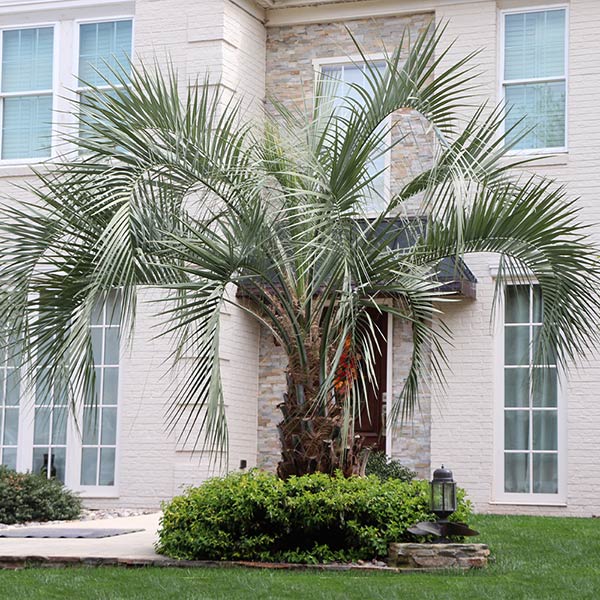Southern Warmth and Charm in Cooler Climates
Yearning to plant a Southern Palm even though you're just North of the Mason Dixon line? Then warm up to the Pindo Palm. This date palm with desert appeal can withstand the chilliest Southern winters. And it's a gorgeous, low-growing palm that will produce a hefty yield of juicy, amber-colored fruit in warmer climates.
Basically, its name is well-deserved. So succulent and delicious are the Pindo dates that they are often used to create savory jams and jellies, which is why the Pindo is nicknamed the Jelly Palm. But the pale green leaves are what give the Pindo its character.
Supported by inward curving fronds, the leaves are accentuated by a blue-gray sheen that gives it a distinctive look, unlike any other Palm.
Although it won't grow beyond 20 feet in height, the leaf span can spread to an impressive 15 feet, and its trunk base can exceed 2 feet. Still, the single trunk, slow root growth and extreme drought tolerance make it an excellent candidate for container growing. Pot them up and put them on the patio, the deck, or plant them in your yard to create a relaxing Southern retreat.
Polished, plush and totally posh - this tropical-inspired go-to is a landscape staple. Order your Pindo Palms today!
Looking for more palm trees to add to your collection? Check out our guide to popular .
Planting & Care
Choosing a location: Pindo palms will thrive in a variety of conditions, in cooler climates they will like a full sun location, in warmer areas they will prefer some afternoon shade. Pindo Palms can tolerate almost any soil type and can be grown in small areas like parking lot islands and small spaces. They prefer well-draining soil and can tolerate dry conditions, but look better with adequate moisture.
Planting:
You don't have to immediately repot your plant - you'll only need to repot approximately every other year, once your Palm outgrows its shipped container or original pot. Increase the pot size by 2 inches each time you repot to accommodate new growth.
If growing outdoors make sure you give the palm well-draining soil and adequate space above to grow.
Watering: Palm trees are drought tolerant once established, but will require frequent watering while getting established. Allowing the soil to dry out will weaken the root system of the palm tree, only allow the soil to dry 1-2 inches down before watering again. The frequency will depend on the climate and how much rain you are receiving.
Pruning: Palm trees need very little pruning, only needing brown fronds or old fruit removed on occasion. This can be done any time of the year as needed.
Fertilizing: Young palm trees do not need fertilized until after they put out a new spear, about 2 months. After that they will perform best when fertilized with a slow release fertilizer such a 10-5-10 formula.






Comment